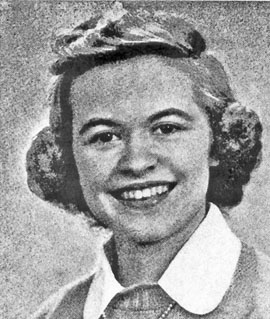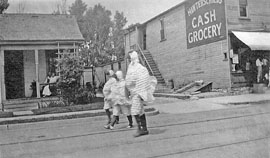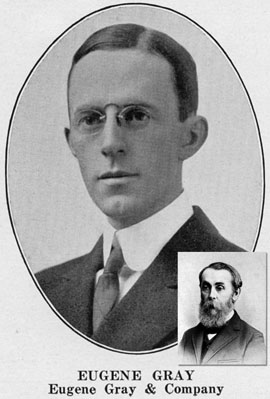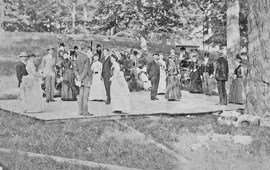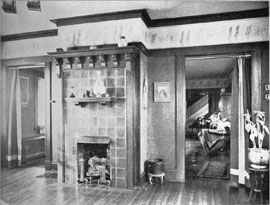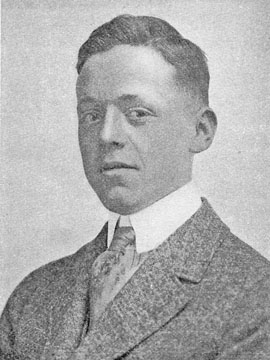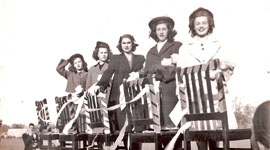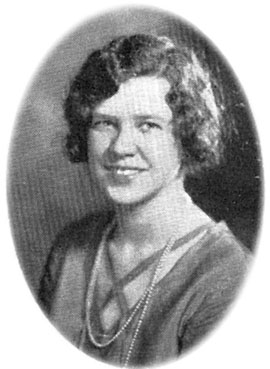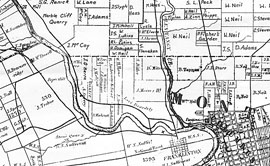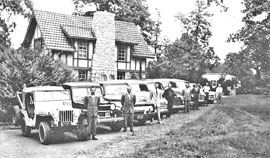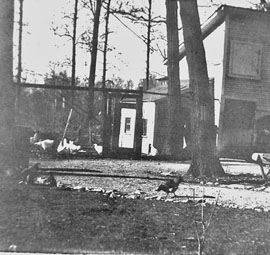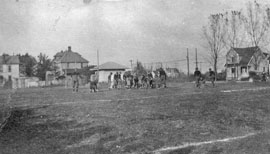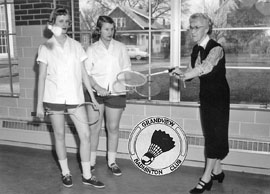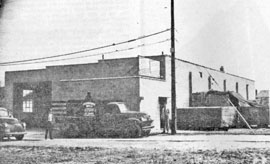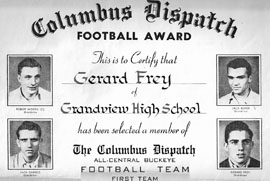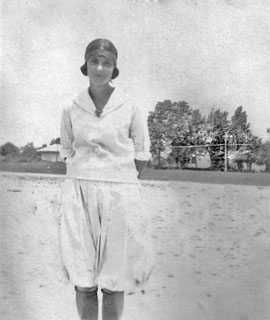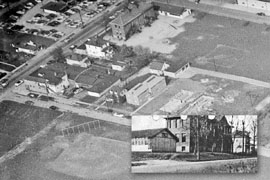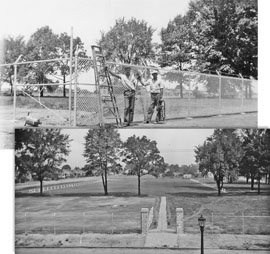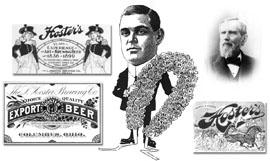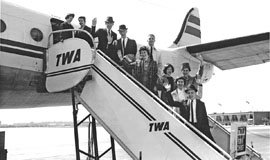This photograph is one of many unidentified items in the Grandview Heights/Marble Cliff Historical Society archives. It is a professional photograph from the Columbus Baker Art Studio and it is identified on the reverse as the "Leap Year Picnic and Dance June 7, 1888". A dance platform was constructed and approximately 30 well-dressed people were in attendance. Though positive identification as to the location and participants is not known for this photo, other information in our archives indicates that employees of the Pittsburgh, Cincinnati, Chicago, and St. Louis Rail Road held a picnic in Marble Cliff in 1892, a favored picnic area. Newspaper accounts of the event indicate a wooden dance platform was constructed in a wooded glen and an African American band called The Elliots provided the music. Close scrutiny of the photo shows a wooden platform, and an African American base player and guitar player at the rear of the dance platform.
This rare interior photograph was identified as being the mantel in the library of the residence of Miss Eva Gray in Grandview Heights. It is from the January 1910 edition of the Ohio Architect and Builder. The promotional photograph was published by J. Upton Gribbon, whose architectural firm had just renovated the home. This residence at 1176 Fairview had been built 5 years earlier for G. Edwin Smith, owner of the G. Edwin Smith Shoe Company. Smith was a manufacturer of ladies' shoes. The home was originally designed and built by Frank Packard. Mr. Gribben worked with Frank Packard from 1895 to 1905, started his own firm in 1906 and was in private practice for 50 years. The home is currently owned by the Kosnik family. This room remains in its original condition.
Alford Bradbury was one of the seven students in the first senior class to graduate from Grandview High School in May of 1916. He was the first Editor in Chief of the Highlander, at the time the school paper rather than a yearbook. Several issues were published during the school year. Alford's picture was the first photograph ever to be published in the Highlander. It appeared in Volume 1, Issue 3 together with the disclaimer that Alford's decision not to publish his photograph was overturned by the faculty advisor and the printer. Senior class pictures became a regular feature of the Highlander by May of 1917.
Pictured above is the GHHS 1944 Homecoming Court. Their wooden chairs were decorated with crepe paper and placed on a raised platform in the middle of the stadium field. Pictured (left to right) are Marion Behm, Pat Johnson, Queen Nancy Matticks, June Day West, and Jeanne Hoffman. Hat and gloves appear to have been standard fashion attire. Queen Nancy was dressed in royal purple and carried yellow chrysanthemums, which she presented to the Bobcat co-captains together with a kiss. Despite her well wishes the Bobcats lost to Academy.
The caption on this photograph indicates that it was taken May 18, 1943 during the GHHS LAL Sorority's "Hell Week". Pledges (left to right) Wanda Rine, Pat Poulton, and Joyce Jones are standing on the east side of Fairview Avenue south of the high school, which is in the left background, with mops, pails, an axe, and a baby carriage. They are dressed like Cockney washwomen with frumpy hats and oversized shawls. State law banned high school sororities and fraternities in the early 1960's. The historical society would like to expand our LAL archive and document from any former members the actual purpose behind the costumes and the events that occurred during "Hell Week". Please contact the GHMCHS at tdemaria@columbus.rr.com with any further information.
This center of this map shows the property which will ultimately become Grandview Heights, Marble Cliff and southern Upper Arlington. Much of the region was originally owned by Lucas Sullivant, who was responsible for surveying the area in the late 1700s. Franklinton, which was platted by Sullivant is shown at the lower right. Many recognizable names are depicted in this 1842 map, including Neil and Fisher (owners of the land which is now OSU), Walcutt (who owned a large parcel in and south of Grandview), Trabue, McCoy, and Lane. The Marble Cliff Quarry is in the upper left, which is the current location of the Scioto Country Club.
Miss Ethel Layland (left) was hired as the first elementary school principal in the Grandview Heights City School district in 1918. She is standing on the steps of the Grandview Elementary School on the west side of Fairview Avenue with Miss Eloise Symons, one of the elementary school teachers. The school was built in 1911 and was administered by the superintendent until Miss Layland was hired. Miss Layland began her teaching career in 1903 in Hopewell Township in Mercer County, where she made $1.25 per day and taught 55 students (all eight grades) in a one-room school. She served the Grandview students for 29 years and retired in 1947. The photograph is from the collection of Marvyth Bonham, who served as a teacher at Edison and R.L Stevenson for over 40 years. She donated her extensive photographic record of school activities to the Grandview Heights/Marble Cliff Historical Society in 1993.
The William and Harriet Lanman mansion, completed in 1908, is located at 2015 West Fifth in Marble Cliff. After several residential owners, including the Ingram family of White Castle fame, it was purchased in 1953 by the civil engineering firm Burgess-Niple, who moved their company headquarters there from East Broad in downtown Columbus. Over 150 engineers, managers and administrative personnel worked in or out of the house. This 1954 photo shows the company's fleet of field jeeps and trucks lining the Lanman's driveway behind the carriage house at the southeast corner of the mansion.
This undated photograph shows the backyard of the Grandview home at 1201 Ashland, complete with a barn, chicken coop, and many chickens. The home was built in 1904. Outbuildings housing chickens, sheep, horses, and cows were common in early Grandview Heights and Marble Cliff, providing shelter for the animals that served the residents both as a food source and for generating extra income. Fresh eggs, chickens, and milk were not always available at the small corner markets of the time. Bradley Skeele recounted in his 1968 memoir that his mother, Nancy, raised chickens at their home at 1492 Roxbury Road and was able to charge a dollar a dozen (equivalent to $13 today) during WWI. She used her profits to buy classical Victrola records and pieces of her Haviland china pattern. In his memoir, Bradley stated that he was so traumatized by caring for the chickens that he never ate chicken again after leaving home.
Extension of the streetcar line across the Goodale Bridge in 1901 contributed significantly to the development of the Grandview Heights and Marble Cliff communities. The 20 minute trip from downtown, via the "Arlington Line", originally ended at the intersection of Arlington and Fifth Avenues (the image at the bottom, circa 1915, shows the car at the end of the line, with the Lanman mansion at 2015 West Fifth in the background). Two tickets (top and middle) were required for a round trip. One was used to travel west of the bridge, another for the part of the trip on the east side. The Sheldon family of Marble Cliff owned the Columbus Railway, Power & Light Company. Buses replaced streetcars in 1937. These tiny, original Arlington Line tickets are from the Alleyne Higgs Jones collection and were recently donated to the GHMCHS by her daughter Jeanne.
The mansion of George and Alice Urlin was built on the hill overlooking the confluence of the Scioto and Olentangy Rivers in 1890. George, one of the earliest residents of what is now Grandview Heights, was an influential businessman and entrepreneur in Columbus at the turn of the century, and was responsible for the platting and development of Grandview Heights. A 1994 residential planning handbook stated that builders in his Urlin Terrace Subdivision were not allowed to build their home closer to the street than his home was. The mansion was a landmark in the community, visible from afar sitting high on the hill. An image of the home is included as the logo of the Grandview Heights/Marble Cliff Historical Society. Urlin died in 1942, and the house was torn down several years later (this 1944 photo shows the home being razed.) The property was later acquired for the development of the Summit Chase residential tower.
This photograph shows a panoramic view, facing northeast, of the intersection of Fairview and Third Avenues about 1922 just prior to the construction of the Grandview High School. The football team is practicing in the foreground. Norma Goss recounted in her 1935 GHHS senior commencement address that two houses were originally present on the west side of Fairview between First and Third Avenues. One was moved to an empty lot on Fairview, the other to Oakland Ave. At the time this photograph was taken a large brick home had already been replaced by the football field. Eventually, all the buildings on the left were removed to build GHHS. The house on the right side of the picture has survived. It is located at 1338 Fairview, across from the exit of the faculty parking lot on the east side of the original section of the High School.
The GHMCHS has considerable documentation in its archives of various community and school organizations and clubs, including the Friendly Book Club, the Black Mask Club, Grandview Civic, the Garden Club etc. It appears from the blue and white logo shown in the inset in this photo that at some point in time there was also a "Grandview Badminton Club". A piece of stationery bearing the logo was recently added to our collection and is a bit of a puzzle. Badminton was added as a Girls Athletic Council intramural sport at the high school in 1937 and was second in popularity to basketball. The photo shows Emily Peterson, GHHS Girls Athletic Director, demonstrating proper badminton form to two high school girls. There doesn't seem to be any substantiated evidence that formally links the logo with the High School. If anyone can provide additional information regarding the "Grandview Badminton Club" please contact us at tdemaria@columbus.rr.com
Kingswood Lumber most recently was located at 900 West Third in the Grandview area. But it was originally located on Grandview Avenue near St. Christopher's Catholic Church, in the complex that recently was razed by fire. Ferd Wolf founded the Wolf Construction Co. in 1925, and changed the name to C & W Construction in the mid-1930s. C&W Construction became Kingswood Lumber after World War II. The Wolf family moved the lumber yard to the Third Avenue location in the early 1970s. The main retail store and office facility was destroyed by fire in 1978. This photo shows the Grandview Avenue location just prior to the move to Third Avenue.
Gerard "Bud" Frey was a member of GHHS Class of 1948 and a halfback of the 1947 Central Buckeye League champion football team that finished the year undefeated. He is shown on the bottom right of this 1947 Columbus Dispatch Football Award Certificate. Seven of the ten players who were named to the 1947 All-Central Buckeye Football Team were from GHHS. He was inspired by Coach Thackara and at his behest spent the summer working as a lumberjack in Lancaster, New Hampshire. Among his written recollections were fond memories of his good buddies: Jim Brown, Bob (Morso) Morris, Jack (Flea Bit) Roth, and the Ruby twins. Bud passed away in 2007 and his family recently donated all his GHHS memorabilia to the Historical Society with the hopes "that it engender fond memories for those alumni viewing it".
Alleyne Higgs, a member of the 1922 GHS senior class, is pictured wearing her G.A.A. (Girls Athletic Association) baseball uniform. Basketball was the only interscholastic sport available to girls at the time, so G.A.A. was established to provide opportunities for girls to be involved in sports. G.A.A. was open to any young woman at GHS, and to be eligible a student had to participate in at least two major sports a year. Points were given for scholarship, athletic ability, posture, good sportsmanship, etc. After accumulating 1,000 points an individual was given a blue and white G.A.A. letter. The intramural sports available were: tennis, hockey, basketball, ping-pong, volleyball, baseball, "outing", and track. At the time the importance of physical education was just beginning to be recognized and incorporated into high school curricula nationally.
This circa 1954 aerial photograph shows the old Broadview School (also known as the Fifth Avenue School) in the upper center. (The inset shows a street level view of the front of the school.) Fifth Avenue runs diagonally at the left, and Broadview Avenue is at the top. At the bottom is the baseball field at the north end of the GHHS athletic property. The Broadview School was torn down, and in the 1970s the property was purchased to build a Friendly's Ice Cream restaurant, and later was renovated for a Starbucks.
Started during the Great Depression, the federal WPA (Works Progress Administration) provided funds for construction, renovation and other projects across the country until the postwar boom in 1943. In Grandview the WPA was responsible for constructing, renovating and maintaining city school district buildings and grounds. The program earmarked $28,000 for the construction of a new stadium on the athletic field north of the GHHS on the condition that the district could contribute $3,000 towards the construction effort. The top photo shows WPA workers doing site preparation by erecting a barbed wire chain link fence. They are standing at the northwest corner of Fairview and Third Avenues. The bottom photo shows the athletic field just prior to construction of the stadium. The 1250 seat stadium was completed and dedicated on October 7, 1938. The construction was not without considerable political drama and controversy. Visit the “History of the Schools” link at the GHMCHS web site at www.ghmchs.org for additional details.
Early Marble Cliff resident Carl Hoster is depicted in this drawing, taken from a book of caricatures of famous Columbus men. He was the President of the Hoster-Columbus Associated Brewing Company, which was established in 1904. The company was created from the merger of three pioneer Columbus breweries, the L. Hoster Brewing Co. (founded in 1836 by Louis Hoster, shown at the upper right), Conrad Born's Capital Brewery, and Nicholas Schee's Bavarian Brewery, all located in what is now the Brewery District in Columbus. Hoster is shown holding the flower arrangement placed around the neck of the winner of the nationally famous Hoster-Columbus $10,000 Stake horse race, which he founded. The three insets are taken from early Hoster Brewing advertisements.
This photograph was taken in 1961 as members of the GHHS Student Council and chaperones were about to depart on a TWA flight east for a student exchange with Jeb Stuart High School in Falls Church, VA. To finance the exchange, students managed the school’s supply room sales, sponsored dances, and sold doughnuts and bumper stickers. Several of the students pictured include: Jim Smith, Dave Fink, John Arganbright, Penny Basler, and Mike Bordner. It appears that standard attire for air travel 48 years ago was quite formal. At the time narrow neckties were at the height of fashion for men.
Grandview Heights High School civics students and their teacher, Fred Robinson (center) are shown entering Veteran's Memorial to attend the "Central Ohio School of Anti-Communism" in this November, 1961 photo. This "school" was similar to many others across the country that proliferated during the Cold War period of our history. Built around a U.S. military endorsed program called Project Alert, these three and a half hour sessions were designed to indoctrinate young people to the threat of communism. As a result of post-McCarthy era investigations by Senator William Fulbright in the same year, the Project Alert program was exposed to be part of an ultra-right wing extremist movement, and President Kennedy eventually ordered the military to drop their support of the programs.
